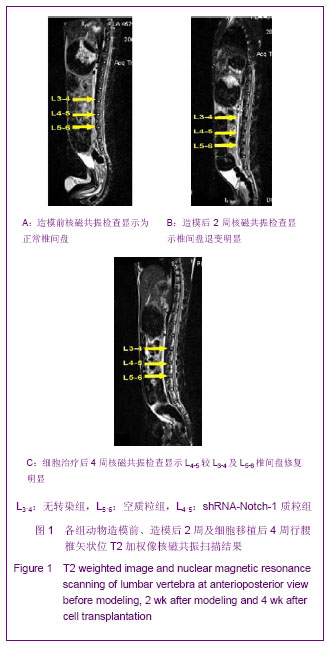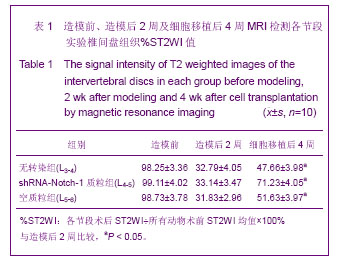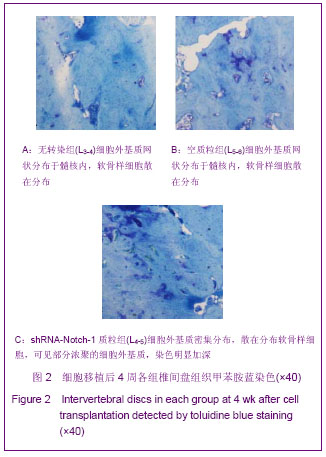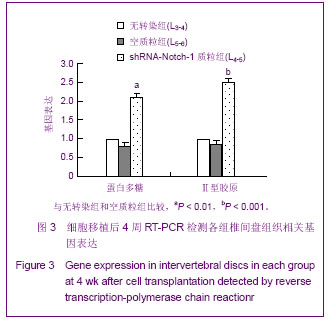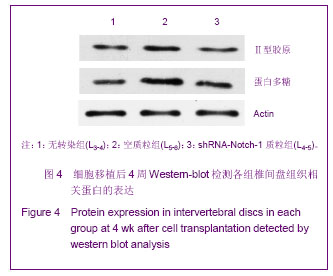| [1] Kalson NS, Richardson S, Hoyland JA. Strategies for regeneration of the intervertebral disc. Regen Med. 2008;3(5): 717-729.
[2] Ruan D, He Q, Ding Y,et al. Intervertebral disc transplantation in the treatment of degenerative spine disease: a preliminary study. Lancet. 2007;369(9566):993-999.
[3] 肖剑,贾连顺,程岚,等.兔腰椎间盘髓核细胞活力测定及外源性基因在其中的表达[J].中国临床康复,2002,6(20):3023-3024.
[4] Erwin WM, Ashman K, O'Donnel P,et al. Nucleus pulposus notochord cells secrete connective tissue growth factor and up-regulate proteoglycan expression by intervertebral disc chondrocytes. Arthritis Rheum. 2006;54(12):3859-3867.
[5] 胡资兵,曾荣,郭伟韬,等.骨髓间充质干细胞诱导分化特征[J].中国组织工程研究与临床康复, 2008,12(43):8561-8566.
[6] Baksh D, Song L, Tuan RS. Adult mesenchymal stem cells: characterization, differentiation, and application in cell and gene therapy.J Cell Mol Med. 2004;8(3):301-316.
[7] Indrawattana N, Chen G, Tadokoro M,et al. Growth factor combination for chondrogenic induction from human mesenchymal stem cell. Biochem Biophys Res Commun. 2004;320(3):914-919.
[8] Schwanbeck R, Schroeder T, Henning K,et al. Notch signaling in embryonic and adult myelopoiesis.Cells Tissues Organs. 2008;188(1-2):91-102.
[9] Hayes AJ, Dowthwaite GP, Webster SV,et al.The distribution of Notch receptors and their ligands during articular cartilage development. J Anat. 2003;202(6):495-502.
[10] Andersson ER, Sandberg R, Lendahl U. Notch signaling: simplicity in design, versatility in function. Development. 2011; 138(17):3593-3612.
[11] Wu L, Sun T, Kobayashi K, et al. Identification of a family of mastermind-like transcriptional coactivators for mammalian notch receptors.Mol Cell Biol. 2002;22(21):7688-7700.
[12] Iso T, Kedes L, Hamamori Y. HES and HERP families: multiple effectors of the Notch signaling pathway.J Cell Physiol. 2003;194(3):237-255.
[13] Hiyama A, Skubutyte R, Markova D,et al.Hypoxia activates the notch signaling pathway in cells of the intervertebral disc: implications in degenerative disc disease. Arthritis Rheum. 2011;63(5):1355-1364. .
[14] Colombini A, Lombardi G, Corsi MM,et al. Pathophysiology of the human intervertebral disc. Int J Biochem Cell Biol. 2008; 40(5):837-842.
[15] Risbud MV, Albert TJ, Guttapalli A,et al. Differentiation of mesenchymal stem cells towards a nucleus pulposus-like phenotype in vitro: implications for cell-based transplantation therapy. Spine (Phila Pa 1976). 2004;29(23): 2627-2632.
[16] Bertolo A, Mehr M, Aebli N,et al. Influence of different commercial scaffolds on the in vitro differentiation of human mesenchymal stem cells to nucleus pulposus-like cells. Eur Spine J. 2012;21 Suppl 6:S826-838.
[17] Richardson SM, Curran JM, Chen R,et al.The differentiation of bone marrow mesenchymal stem cells into chondrocyte-like cells on poly-L-lactic acid (PLLA) scaffolds. Biomaterials. 2006;27(22):4069-4078.
[18] Sakai D, Mochida J, Yamamoto Y,et al. Transplantation of mesenchymal stem cells embedded in Atelocollagen gel to the intervertebral disc: a potential therapeutic model for disc degeneration. Biomaterials. 2003;24(20):3531-3541.
[19] Acosta FL Jr, Metz L, Adkisson HD,et al. Porcine intervertebral disc repair using allogeneic juvenile articular chondrocytes or mesenchymal stem cells.Tissue Eng Part A. 2011;17(23-24):3045-3055.
[20] 王佳,陈晓禾,黄永灿,等.缺氧对hBMSCs和胎盘来源MSCs增殖的影响[J].中国修复重建外科杂志,2009, 23(2):136-139.
[21] Wuertz K, Godburn K, Neidlinger-Wilke C,et al. Behavior of mesenchymal stem cells in the chemical microenvironment of the intervertebral disc.Spine (Phila Pa 1976). 2008;33(17): 1843-1849.
[22] Moore KA, Lemischka IR.Stem cells and their niches.Science. 2006;311(5769):1880-1885.
[23] Wuertz K, Godburn K, Neidlinger-Wilke C,et al.Behavior of mesenchymal stem cells in the chemical microenvironment of the intervertebral disc.Spine (Phila Pa 1976). 2008;33(17): 1843-1849.
[24] Sulkowski S, Wincewicz A, Sulkowska M,et al.Transforming growth factor-beta1 and regulators of apoptosis. Ann N Y Acad Sci. 2009;1171:116-123.
[25] Bosnakovski D, Mizuno M, Kim G, et al. Chondrogenic differentiation of bovine bone marrow mesenchymal stem cells (MSCs) in different hydrogels: influence of collagen type II extracellular matrix on MSC chondrogenesis.Biotechnol Bioeng. 2006;93(6):1152-1163.
[26] Steck E, Bertram H, Abel R,et al. Induction of intervertebral disc-like cells from adult mesenchymal stem cells.Stem Cells. 2005;23(3):403-411. |
